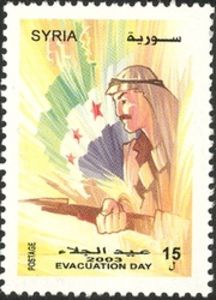“The flutter of hopes and the beat of the heart,
are on a flag that united the entire country.
Is there not blackness from every eye,
and ink from every martyr’s blood?”
Third stanza of Syria’s National Anthem, Humat Al-Diyar (Guardians of the Homeland). 1936.
Across every corner of Syria, at every protest, Free Syrian Army checkpoint and every liberated square you’ll find the red, white & green Revolutionary flag, standing tall – or more precisely, Syria’s Flag of Independence.


Despite the Assad regime’s attempts to marginalize this flag by shamelessly slandering it as the “French” flag they cannot cover up that it has been an important part of Syria’s history and that every Syrian President from Muhammad Ali al-Abd of the Syrian Republic, to Shukri al-Quwatli, Adib Shishakli, Hashim Atassi to even Assad have stood before it.

The flag was defined in the 1930 Syrian Republic constitution, under the oversight of one of Syria’s most celebrated heroes, Ibrahim Hananu. It was first hailed in Aleppo & Damascus in 1932 and soon became a powerful symbol of resistance against the French colonists. On April 17th 1946, Independence (or Evacuation) Day, it was adopted as the flag of the newly independent state.


The flag immediately served as important symbolic unifier for the nation. The three stars represent the great uprisings against the French – Salih Ali revolt in 1919, Ibrahim Hananu’s Aleppo uprising and Sultan al-Atrash uprising in 1925. It’s colors, green for the Rashidun & Islam, black for the Abbasid Caliphate, white for the Umayyads and red in honor of the nations martyrs. Syria’s national anthem, Humat Al-Diyar, written in 1936 also pays homage to it.

The Independence flag was briefly replaced when Syria united with Egypt to form the “United Arab Republic” in 1958, but was, however, reestablished when the union fell apart in 1961.
As an important sidenote, the word “Arab” in the current name “Syrian Arab Republic” was first instituted after the collapse of the Union with Egypt, due to the heavy Egyptian/Nasserite influence. It was left out at Independence by the Founding Fathers out of respect for Syria’s diversity.

Demoted by the Ba’ath and the Assad family since 1963, the longest-standing icon of the modern nation state of Syria has now seen a resurgence as a bold symbol of independence and rebellion to the regime.
This came naturally for a population rejecting the imposed state symbols that became synonymous with the Assad regime – namely, the Ba’ath and official state flags, always strategically associated with images of Hafez, Bashar and even Basil Al-Assad (I remember once counting over 400 images of Hafez Al-Assad in a 4 story elementary school stairwell as a child).

The adoption of the Independence flag for this revolution is truly fitting. Today, the Syrian struggle for independence continues – only this time against a family regime that has treated the nation as its colony for generations.
#
For an album of images featuring the Flag of Independence visit here. Also, here are more stamps from our history featuring our national Flag of Independence:














If you have more examples of the Independence Flag in use over the years, please share, and I will add. Thank you.

This is your grandfather?
http://en.wikipedia.org/wiki/Adib_Shishakli
LikeLike
Yes he is, Abu abooyi
LikeLike
Interesting article Sarab. Thank you for sharing! I need a clarification; it appears from the dates on the stamps that the assad regime still used the old flag in parallel with the other. Did attempts to marginalize it started with the rise of revolution or before that? Also, is the info in the wikipedia link about your grandfather all correct? Best!
LikeLike
Thank you for your interest and comment on the piece.
The Independence flag was marginalized prior to the revolution as the Assad’s and Ba’ath prioritized both the “red” flag and the Ba’ath flag (often overlayed with images of the Assad’s) to further connect state power & Assad family. Of course, when protestors in 2011 picked up flag as a symbol of resistance to the regime, the disinformation campaign against the symbol went into high gear.
There are some areas in my grandfather’s wikipedia entry that require closer study/research. Much of what was written about him was done so from the Ba’ath perspective as they have controlled Syria’s history narratives (and opposed Shishakli). Did you have any specific questions?
LikeLike
Lak tislamli! thanks for this post… it clarifies so much
LikeLike
very precious materials,
thank you very much
LikeLike
This is really a great blog. Thank you so much for this
LikeLike